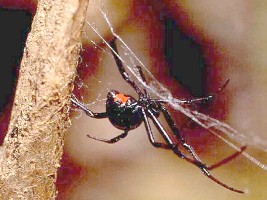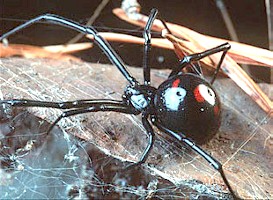More than 35,000 species of spiders occur in the world. Of these, about 3,400 are found in North America. The Black Widow Spider is the common name for several related long-legged, smooth-bodied spiders that live in areas ranging from the Tropics, most of the United States, and as far north as Canada. The shiny black body and red hourglass shape on its abdomen are easily recognizable characteristics of the Black Widow female; the smaller males are a dull brown, and harmless. Black Widow females spin irregular webs in crevices and other dark, protected spots, especially in wood piles, under the eaves of homes, in cardboard boxes stored on porches, in outdoor toilets, meter boxes and other such sheltered areas. Three other species are also poisonous to humans: the brown widow, the red widow, and the northern widow spider. Their markings are somewhat different than the Black Widow.  The male measures a tiny 1/8 inch long, and the female is only slightly larger, at 3/8 of an inch (just over a centimetre) in length. Bites in humans only occur from the larger female. Her venom is 15 times more potent than an equal weight of rattlesnake venom ... but her tiny fangs inject only a small amount. As a result, fatalities caused by bites are rare, but the bites do cause swelling, discomfort, nausea, and difficulty in breathing, and are only occasionally fatal. The venom, a neurotoxin, generally affects children more severely than adults. With healthy people, recovery is usually complete in 2 to 5 days. However, this spider is considered the most venomous spider in North America.
The male measures a tiny 1/8 inch long, and the female is only slightly larger, at 3/8 of an inch (just over a centimetre) in length. Bites in humans only occur from the larger female. Her venom is 15 times more potent than an equal weight of rattlesnake venom ... but her tiny fangs inject only a small amount. As a result, fatalities caused by bites are rare, but the bites do cause swelling, discomfort, nausea, and difficulty in breathing, and are only occasionally fatal. The venom, a neurotoxin, generally affects children more severely than adults. With healthy people, recovery is usually complete in 2 to 5 days. However, this spider is considered the most venomous spider in North America. The Black Widow is not an aggressive spider, but it will bite instinctively when touched or disturbed, or when it is guarding an egg sac.  These spiders spin tangled, irregular webs of coarse silk in dark places, usually outdoors near the ground. The female lays eggs in silken cocoons or sacs, which are about 1/2-inch in diameter. Sacs are white at first, later turning pale brown. About 300 to 400 eggs per sac is common, and 4 to 9 egg sacs are produced during a summer. Normally, only a few young survive from each sac, after the egg incubation period of 14 to 30 days. Females mature about 3 months after they emerge from the sac, and live about 6 months after that. Males have a much shorter life span.
These spiders spin tangled, irregular webs of coarse silk in dark places, usually outdoors near the ground. The female lays eggs in silken cocoons or sacs, which are about 1/2-inch in diameter. Sacs are white at first, later turning pale brown. About 300 to 400 eggs per sac is common, and 4 to 9 egg sacs are produced during a summer. Normally, only a few young survive from each sac, after the egg incubation period of 14 to 30 days. Females mature about 3 months after they emerge from the sac, and live about 6 months after that. Males have a much shorter life span.Occasionally the female eats the male after mating, but if she is well fed, the male will likely escape. Females rarely leave the web, although cold weather or drought may drive them into buildings. Prey caught in the web include a variety of insects, including cockroaches and beetles. |
